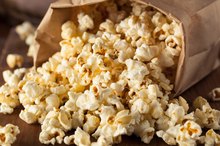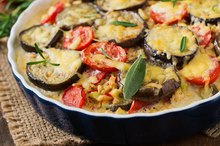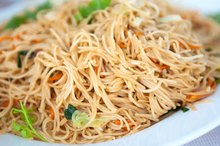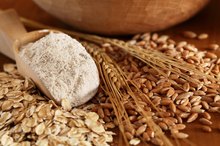What does fact checked mean?
At Healthfully, we strive to deliver objective content that is accurate and up-to-date. Our team periodically reviews articles in order to ensure content quality. The sources cited below consist of evidence from peer-reviewed journals, prominent medical organizations, academic associations, and government data.
- MayoClinic.com; Exercise for Weight Loss: Calories Burned in 1 Hour; December 2009
- MayoClinic.com; Dietary Fats: Know Which Types to Choose; February 2011
- "European Journal of Applied Physiology"; Influence of Dietary Carbohydrate Intake on Free Testosterone: Cortisol Ratio Responses to Short-Term Intensive Exercise Training; A.R. Lane, et. al; April 2010
- "European Journal of Applied Physiology"; Influence of Dietary Carbohydrate Intake on Free Testosterone: Cortisol Ratio Responses to Short-Term Intensive Exercise Training; A.R. Lane, et. al; April 2010
The information contained on this site is for informational purposes only, and should not be used as a substitute for the advice of a professional health care provider. Please check with the appropriate physician regarding health questions and concerns. Although we strive to deliver accurate and up-to-date information, no guarantee to that effect is made.
Is Popcorn as Healthy as Corn on the Cob?
Although popcorn and corn on the cob are both corn products, the two foods have significantly different nutritional profiles, and based on the USDA's dietary recommendations, corn on the cob is healthier. However, different means of preparation can improve the nutritional value of popcorn, but corn on the cob is likely to be more beneficial for weight management and weight loss than popcorn. Consult product labels when available, as nutritional values may vary by brand.
Calorie Content
Popcorn tends to be lower in calories than corn on the cob because of its light, fluffy consistency; this results in a lower calorie-density, so you need to eat larger volumes of popcorn to obtain the same amount of calories as corn on the cob. One cup of popcorn provides 55 calories, while one 7-inch ear of corn on the cob provides 111 calories. If you are active, calorie-dense foods such as corn on the cob can be preferable, as athletic endeavors burn a significant amount of calories; an hour of jumping rope burns 730 calories, while an hour of jogging at 5 mph burns 584. To lose weight, popcorn may be preferable based on its calorie content.
- Popcorn tends to be lower in calories than corn on the cob because of its light, fluffy consistency; this results in a lower calorie-density, so you need to eat larger volumes of popcorn to obtain the same amount of calories as corn on the cob.
- If you are active, calorie-dense foods such as corn on the cob can be preferable, as athletic endeavors burn a significant amount of calories; an hour of jumping rope burns 730 calories, while an hour of jogging at 5 mph burns 584.
Fat Content
Nutrition Facts for Popped Pop Secret Kettle Corn
Learn More
Despite being lower in calories, popcorn is higher in fat than corn on the cob; one cup of popcorn contains 3 g of fat, while a 7-inch ear of corn provides just 1 g of fat. Corn on the cob is also free of saturated fat, while popcorn with a typical preparation contains 0.5 g of saturated fat per cup. Consuming too much saturated fat can increase your cholesterol levels, so the USDA recommends consuming just 7 percent of your calories from this type of fat. If you follow a 2,000-calorie diet, this equates to 15 g of saturated fat.
- Despite being lower in calories, popcorn is higher in fat than corn on the cob; one cup of popcorn contains 3 g of fat, while a 7-inch ear of corn provides just 1 g of fat.
Carbohydrate Content
Carbohydrates are your body's main source of fuel, so the Food and Nutrition Board of the National Academies recommends consuming at least 130 g each day 3. Based on this suggestion, corn on the cob is preferable, as a 7-inch ear provides 26 g of carbohydrates, compared to 6.3 g in a cup of popcorn. If you are active, consuming adequate amounts of carbohydrates is vital; a study from the April 2010 edition of the "European Journal of Applied Physiology" found that pairing intensive exercise with a low-carbohydrate diet produced a decrease in testosterone levels 4.
Fiber Content
The Nutrition of Moussaka
Learn More
Dietary fiber is a vital nutrient that can help you manage your weight, as it produces feelings of satiety. Additionally, dietary fiber aids in digestion and can help you manage your cholesterol levels. Corn on the cob is higher in fiber, with 3 g in each 7-inch ear, while popcorn contains 1 g per cup.
Protein Content
Both corn on the cob and popcorn are low in protein. A 7-inch ear of corn on the cob contains 3 g of protein, while popcorn contains 1 g per cup. Protein helps build and repair your body's cells and tissues, so it's important to eat protein-rich foods each day. MedlinePlus, a publication of the National Institutes of Health, suggests eating 50 to 65 g of protein daily.
- Both corn on the cob and popcorn are low in protein.
- A 7-inch ear of corn on the cob contains 3 g of protein, while popcorn contains 1 g per cup.
Related Articles
References
- MayoClinic.com; Exercise for Weight Loss: Calories Burned in 1 Hour; December 2009
- MayoClinic.com; Dietary Fats: Know Which Types to Choose; February 2011
- "Dietary Reference Intakes for Energy, Carbohydrate, Fiber, Fat, Fatty Acids, Cholesterol, Protein, and Amino Acids (Macronutrients)"; Food and Nutrition Board of the National Academies; National Academies Press; 2005
- "European Journal of Applied Physiology"; Influence of Dietary Carbohydrate Intake on Free Testosterone: Cortisol Ratio Responses to Short-Term Intensive Exercise Training; A.R. Lane, et. al; April 2010
- Nguyen, V., Cooper, L., Lowndes, J. et al. Popcorn is more satiating than potato chips in normal-weight adults. Nutr J 11, 71 (2012). doi:10.1186/1475-2891-11-71
- Coco MG, Vinson JA. Analysis of popcorn (Zea mays L. var. everta) for antioxidant capacity and total phenolic content. Antioxidants (Basel). 2019;8(1). doi:10.3390/antiox8010022
- Zhou Y, Zheng J, Li Y, et al. Natural polyphenols for prevention and treatment of cancer. Nutrients. 2016;8(8) doi:10.3390/nu8080515
- Cleveland Clinic. Diverticular disease: greatest myths and facts. 2020.
- American Cancer Society. Teflon and perfluorooctanoic acid (PFOA). Updated January 5, 2016.
- Begley TH, White K, Honigfort P, Twaroski ML, Neches R, Walker RA. Perfluorochemicals: potential sources of and migration from food packaging. Food Addit Contam. 2005;22(10):1023-31. doi:10.1080/02652030500183474
- American College of Allergy, Asthma & Immunology. Corn allergy. Updated March 8, 2019.
- American Chemical Society (ACS). Popcorn: The snack with even higher antioxidants levels than fruits and vegetables. ACS Meeting; San Diego, California; March 25, 2012.
Resources
Writer Bio
Brian Willett began writing in 2005. He has been published in the "Buffalo News," the "Daytona Times" and "Natural Muscle Magazine." Willett also writes for Bloginity.com and Bodybuilding.com. He is an American Council on Exercise-certified personal trainer and earned a Bachelor of Arts in journalism from the University of North Carolina.









